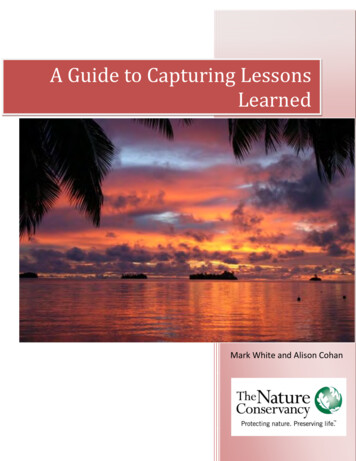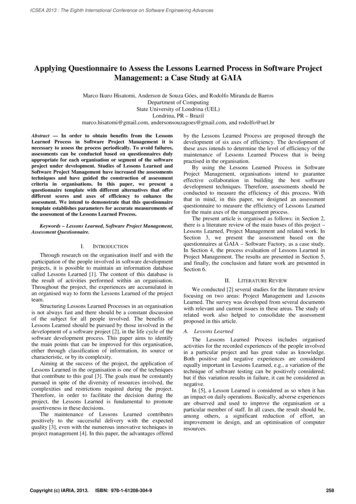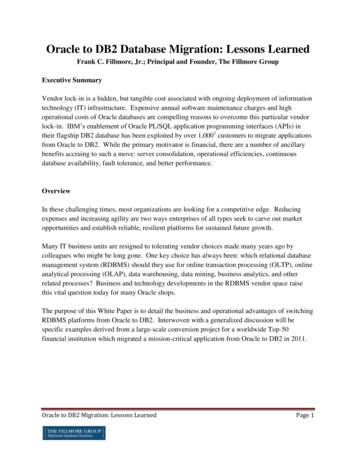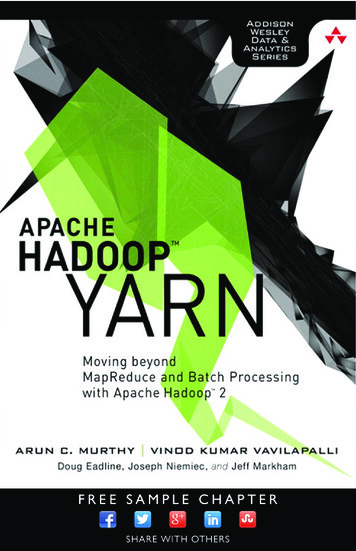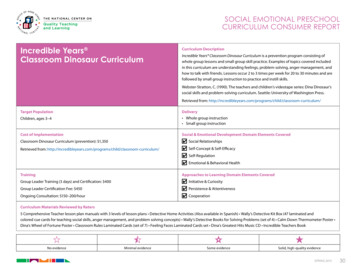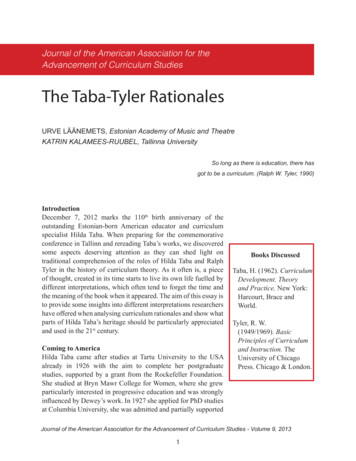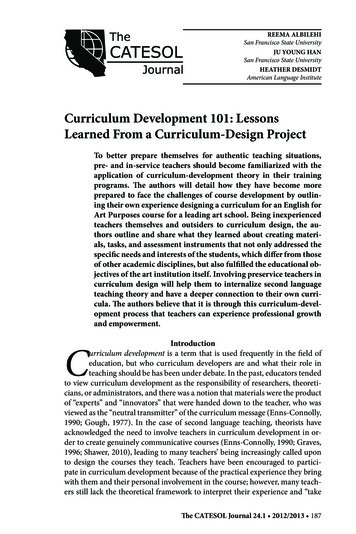
Transcription
REEMA ALBILEHISan Francisco State UniversityJU YOUNG HANSan Francisco State UniversityHEATHER DESMIDTAmerican Language InstituteCurriculum Development 101: LessonsLearned From a Curriculum-Design ProjectTo better prepare themselves for authentic teaching situations,pre- and in-service teachers should become familiarized with theapplication of curriculum-development theory in their trainingprograms. The authors will detail how they have become moreprepared to face the challenges of course development by outlining their own experience designing a curriculum for an English forArt Purposes course for a leading art school. Being inexperiencedteachers themselves and outsiders to curriculum design, the authors outline and share what they learned about creating materials, tasks, and assessment instruments that not only addressed thespecific needs and interests of the students, which differ from thoseof other academic disciplines, but also fulfilled the educational objectives of the art institution itself. Involving preservice teachers incurriculum design will help them to internalize second languageteaching theory and have a deeper connection to their own curricula. The authors believe that it is through this curriculum-development process that teachers can experience professional growthand empowerment.CIntroductionurriculum development is a term that is used frequently in the field ofeducation, but who curriculum developers are and what their role inteaching should be has been under debate. In the past, educators tendedto view curriculum development as the responsibility of researchers, theoreticians, or administrators, and there was a notion that materials were the productof “experts” and “innovators” that were handed down to the teacher, who wasviewed as the “neutral transmitter” of the curriculum message (Enns-Connolly,1990; Gough, 1977). In the case of second language teaching, theorists haveacknowledged the need to involve teachers in curriculum development in order to create genuinely communicative courses (Enns-Connolly, 1990; Graves,1996; Shawer, 2010), leading to many teachers’ being increasingly called uponto design the courses they teach. Teachers have been encouraged to participate in curriculum development because of the practical experience they bringwith them and their personal involvement in the course; however, many teachers still lack the theoretical framework to interpret their experience and “takeThe CATESOL Journal 24.1 2012/2013 187
control” of their teaching through certain curriculum-development strategies(Enns-Connolly, p. 501). However, teachers must understand that they playan important role in course design because they are the ones who deliver instructions in accordance with a curriculum, and they are the ones who bridgethe gap between what has been described in a curriculum and what is actuallybeing done in the classroom. By understanding the framework of curriculumdevelopment, teachers can “make sense” of what they are doing and not just doit (Graves, p. 6)As graduate students of a MA TESOL program, we did not consider ourselves capable of being curriculum developers because of our lack of knowledge,but we were aware of the fact that course design was not a rare practice, evenfor new teachers. To our surprise, many in-service ESL teachers also vocalizesimilar opinions of not feeling fully equipped when it comes to approachingand tackling curricula. Our desire to gain expertise and to prepare ourselves forthe future prompted us to enroll in a seminar course in curriculum and assessment at our university. We entered the class with foundational and theoreticalknowledge of how to teach the four skills and had some exposure to second language learners through our work as tutors and teaching assistants in both academic and nonacademic ESL classrooms. However, we left the class with quitea different set of beliefs, attitudes, and strategies as English language teachers,and this change is indexical of teacher growth and development (Voogt et al.,2011). Through this course, we were equipped with the conceptual frameworkfor “making sense” of the curriculum-development process that would enableus to apply this knowledge to a real-life language-learning situation, or “case.”As Graves (1996) explains in her book, Teachers as Course Developers,the experience of developing a course enables teachers to make sense ofthe theories and expertise of others because it gives them opportunities toclarify their understanding of theory and make it concrete. Their practicein turn changes their understanding of the theories. (p. 6)This Curriculum and Assessment course helped make our understanding oftheory concrete through our experience developing an actual curriculum foran advanced integrated ESL course at a leading art university in San Francisco.This article begins by situating the project we were assigned to work onand outlining the indications we were given for developing the curriculum.Following the contextualization is an overview of the curriculum-developmentprocess that we went through and how we addressed the unique needs of thestudents and fulfilled the educational objectives of the institution. This articleconcludes with reflections on our experience of making sense of theory andinsight into the role curriculum development has played in our professionaldevelopment.ContextOur directive for the curriculum-development project was to (a) surveythe course that was already in place; (b) evaluate the curriculum; and (c) look188 The CATESOL Journal 24.1 2012/2013
for areas of improvement. The administrators hoped that having the studentsand teachers surveyed and the curriculum evaluated by “outsiders” would givethem an extensive view of the course and perhaps their program on the whole.The institution encouraged feedback and suggestions from us that would leadto the development of a curriculum that would “increase student satisfaction,give students the opportunity to think critically, have focused tasks, enlightenstudents, and encourage them to take knowledge into their own hands” (personal communication). We interpreted these directives to mean we should assess the course and suggest possible improvements in the course to increasestudents’ motivation while meeting the institutional goals.The course we were asked to assess was called English for Art Purposes(EAP), which is essentially an English for Specific Purposes (ESP) program thatprepares international students to (a) participate actively in college classes; (b)express themselves clearly in art critiques; (c) understand lectures and American idiomatic speech; (d) improve reading skills; (e) increase art and designvocabulary; and (f) write papers for class assignments. Today, there are morethan 5,000 international students enrolled (30% of students enrolled) in theart university, which makes it the largest art-oriented English as a Second Language (ESL) program in the world (Preece, 2008).Along with their ESL classes, EAP students are allowed to enroll right awayin art and design classes that correspond to their major. To be successful inthese and future classes at the university, they are expected to be competentin all language modalities; however, listening and speaking skills play a special role for these students. When we were trying to obtain more informationabout the nature of English for art and design purposes, one of the instructorsat the university revealed that the need for strong listening and speaking skillsis greater than the need for strong reading and writing skills (personal communication). Students also need to be well acquainted with the spoken vocabularythat is used during lectures in art classes to facilitate their comprehension. Inaddition, art students must be linguistically prepared to discuss their own projects and provide critiques of the works of others. Reading and writing competence is necessary for them to be able to carry out research and to succeed intheir future composition classes at AAU.The Curriculum-Development Process: Where to Begin?According to Richards (2001) curriculum development refers to the “rangeof planning and implementation processes involved in developing or renewinga curriculum” (p. 41). Many curriculum-development textbooks present thestages of the curriculum-development process as follows:1.2.3.4.5.Needs analysis;Setting goals and objectives;Course organization;Selecting and preparing teaching materials; andEvaluation.The CATESOL Journal 24.1 2012/2013 189
Lacking experience in developing a curriculum, at first we tried to follow theexact order of the curriculum-development process based on the progressionof our Curriculum and Assessment course and the textbooks we were using inour class. However, after many failed attempts to achieve our directives for thecourse design, we realized that we must approach the process from a differentangle.Instead of following the presented order from our textbooks, which is todetermine goals and objectives before deciding course content, we decided toapproach the process backward by first setting principles for the course content, next evaluating and revising the existing assignments based on identifiedstudents’ needs, then deciding the scope and sequence of the content, and finally eliciting objectives students would be able to achieve. From this experience,we learned that curriculum development is “a framework of components thatoverlap both conceptually and temporally” (Graves, 1996, p. 5), which meansthat curriculum developers should start wherever and whenever they think it issuitable in their own situations.In this section, first we will focus on our backward approach to articulating goals and objectives of the EAP course. Then we will reflect on how ourapproach to curriculum development helped us understand the interactive dynamic among the framework components of the course-construction processand enabled us to map our own stages of the process that made sense to us.What follows is an outline of the stages of the curriculum-development processwe were involved in. In the following section, these stages will be outlined inmore depth.1.2.3.4.5.6.7.8.9.Conduct needs and situation analyses.Conceptualize the content.Evaluate existing assignments based on students’ needs and institutional goals.Identify what was missing or lacking in the existing assignments.Revise and change assignments to fulfill course goals, bring unity tothe course, and motivate students.Articulate the goals and objectives based on the assignments we determined.Compare them with the existing ones, and then add our goals andobjectives to the existing ones.Organize unit content (scope and sequence) and developing of coursematerials.Choose evaluation methods that connected and built off one another.Conducting a Needs and Situation AnalysisWe began with a needs analysis, as all curriculum-development textbooksoutline this as the starting point of curriculum design. We designed and conducted a questionnaire to elicit from the current EAP students what Brindley (1989) referred to as objective (i.e., language needs) and subjective (i.e.,190 The CATESOL Journal 24.1 2012/2013
affective and cognitive) needs. By analyzing the results of the questionnaire,we extracted necessary information such as who the students were, what theirgoals were, and what their learning-style preferences were. What stood out tous from the student survey was that students expressed an overwhelming desire to improve their oral English skills; many explained that they wanted tobecome more fluent in order to be successful in future jobs in art and designin the US. The following quote from a student exemplifies the subjective needswe assessed, which guided our decision making in the development process:In 5 years, I plan to be a famous director, I have to speak English fluently tobe able to communicate with those actors and other people in a film crew.After assessing students needs, we conducted a situation analysis to understand factors affecting the EAP curriculum development. From this analysiswe learned what constraints were involved in implementing our curriculum(i.e., teacher and institutional factors); however, we were not sure how to effectively make use of this data. Therefore, we proceeded to the next stage asindicated in our textbook: determining goals and objectives. Not being able tobridge the gap between the two phases (needs and situation analysis and determining goals and objectives), we found ourselves lost in a sea of “SWBAT”s.1We spent many days making lists of goals, objectives, and target skills. Somewere too general and abstract whereas others were too specific. We could notdecide which ones were critical and which were merely desirable. After hoursof discussion and negotiation, we realized that there was a missing step and wedecided that conceptualizing the content before determining goals and objectives might shed some light on our problem and bring about a solution.Conceptualizing the ContentLeft with the question of how to choose and articulate appropriate goalsand objectives, we decided to develop a small set of questions that we could usesystematically to guide us through the goals and objectives articulation process.We asked ourselves the following questions:1.2.3.4.5.6.Who are the students?What are their needs?What is the nature of the course?What should the students be able to do in their art and design classesand outside class?What motivates the students?What did the students learn in their previous English courses andwhat will they need to learn in the following courses?As we were outsiders to the learning situation at hand, these questionshelped us to situate the students and make decisions about what was importantfor the EAP students to learn. With a closer and more systematic investigationThe CATESOL Journal 24.1 2012/2013 191
of the course and learners, we were finally able to set the principles of coursecontent for EAP. Within the realm of English for Art Purposes, we decided thatthe content should:1.2.3.4.5.6.Help students build their future identity as artists;Promote critical thinking and students’ autonomy in their languagelearning;Build study strategies and presentation skills;Give students opportunities to work individually as well as collaboratively;Encourage students’ creativity; and, most of allBe relevant to students’ lives.After analyzing these objectives in relation to the six questions that we askedourselves, we were able to bridge the gap between the needs analysis stage andthe goals and objectives articulation step.Evaluating and Revising Existing AssignmentsOur next step was to look at the existing assignments in the EAP courseand to determine if the tasks effectively addressed the content we conceptualized. By doing so, we were able to articulate the learning objectives, to identifythe missing constructs in the existing tasks, and to make the necessary adjustments to better address students’ needs. By deconstructing each assignment inthis way, we were able to identify the exact learning outcomes and constructsthat were being measured and that should therefore be taught, and we were ableto apply these objectives in creating the new tasks.In the existing curriculum, all assignments were relevant to art and designdiscourse and practices, which include tasks such as writing an essay on modern art and giving presentations on personal artwork. However, among theseassignments, one task seemed out of place. This task was a role-play in whichstudents had to imagine they were soccer coaches and give advice to their trainees. For this task, students were required to demonstrate their pragmatic skills,which are an important component in language acquisition; however, it seemedirrelevant to their needs as art and design students. Therefore, we decided tokeep the pragmatic aspect of the task but to apply it to a situation that was morethematically appropriate.After analyzing the existing assignments and identifying areas for improvement, we revisited the situational analysis, looking at students’ needs in anew light. To better address students’ needs, not only did we change the tasksbut we also fine-tuned the topics and themes to ones that we believed couldengage students’ interest and motivation and provide close relevance to theirlives. In this, we agree with Tomlinson’s (1998) statement that “what is beingtaught should be perceived by learners as relevant and useful” (p. 97) and weemphasize that there should be an apparent relevance between the languageand assignments students use in the classroom and outside class. This approachalso helped us with sequencing assignments so that all tasks would fit into the192 The CATESOL Journal 24.1 2012/2013
larger thematic framework and could eventually fit into the final portfolio. Wethought that by making connections between all of the assignments, then students could revisit their old assignments to revise, recall, reprocess, and editinformation that would help students integrate all that they had learned.Approaching Curriculum DevelopmentVarious concerns have been raised about teachers’ approach to course design because how teachers approach it can have a serious impact on students’learning and motivation. Among teachers’ approaches to curriculum design,Shawer (2010) outlines the fidelity approach, in which teachers transmit thecurriculum as it is; the adaptation approach, in which teachers make adjustments and adaptations to an existing curriculum; and the enactment approach,in which the curriculum is a creation in action. In other words, it is dictatedby the students’ needs and experiences on the spot. The importance of conceptualizing these approaches will help us envision the attitudes that come witheach approach. Teachers who value stability and avoid uncertainty prefer thefirst method, whereas others who value unpredictability and challenges wouldfavor the third method. Through our graduate-course and firsthand experienceworking on a curriculum, we acquired a critical perspective on each of the approaches and the strategies that come with them, and we think that now wewould not be afraid or feel underprepared to deal with any curricular situation.Shawer (2010) states that exposing preservice teachers to these models and theattitudes each model dictates should be part of teaching-training programs.On the one hand, we witnessed the adaptation approach, in which we observed how the EAP staff created, negotiated, and renegotiated the curriculumby supplying concepts, skills, and materials missing in the official curriculum.On the other hand, by employing a detailed situational and needs analysis, weused the curriculum enactment approach. In this model, addressing learners’needs, interests, wants, and abilities is of vital importance. We directed all ourmental and critical powers to creating activities that did not necessarily carryconcrete objectives, but rather those in which students would be able to uselanguage that was meaningful to them. Understanding the importance of addressing students’ needs adequately in the curriculum-development processand having had the experience of trying various curriculum design approaches,we are now less inclined to rely on “prefabricated” lessons of the fidelity approach, but instead we will construct a curriculum that is “uniquely adapted toour students” (Johnson, 1996, p. 769).Teacher Empowerment Through Curriculum DevelopmentFreeman’s (1989) descriptive model for teacher education defines teaching as a decision-making process that involves knowledge, skills, attitudes, andawareness. Our experiences leading up to the Curriculum and Assessmentcourse had given us the knowledge and skills of language-teaching methodology, theoretical linguistics, and second language acquisition, but we had nothad any practical experience teaching in the field yet. Through the curriculumdesign course we gained field experience by working on a real-life “case” thatThe CATESOL Journal 24.1 2012/2013 193
helped us to “foster a change in awareness and attitude” (Fan, 2011, p. 15). Wewere made more aware of our teaching and attitudes through the process ofcurriculum development because we needed to make decisions based on ourown interpretations of the theory and the context we were assigned to. Theorycan inform classroom practice, but it can inform practice “only to the extentto which teachers themselves make sense of that theory” (Johnson, 1996, p.767). By applying these theories to a real context, we were able to make senseof them and internalize them. The source of our pedagogical knowledge, in thiscase, did not lie solely within the courses that we took, but rather the learningexperience that we had.Being given a framework for understanding the course-design process andcarrying out the project, our attitudes about what constitutes good teachingpractices were shaped, which led us to be more confident in our “expertise” andmore prepared to enter the classroom. Now that we have had the experience ofbeing involved in the process of designing a course, we also feel more in controlof our teaching. By taking a more active role in their own curricula, teacherscan become more “deeply involved in their own teaching situations” (EnnsConnolly, 1990, p. 500). We have experienced course design from the curriculum-developers’ perspective, which has allowed us to see how each piece of thecurriculum fits and works together. We can now use this knowledge to createmore effective lesson plans and generate materials that are in line with all aspects of the curriculum and students needs.The Case for a Curriculum-Development Methods CourseIt is not a secret that students learn best when they are actively engagedin their learning process, when they are situated in meaningful contexts, andwhen they collaborate with their peers. Researchers in teacher education havepointed out that this model is not only applicable to students, but to preserviceteachers as well (Putnam & Borko, 2000). In our case, designing a real curriculum for real students is what has become that meaningful genuine context inwhich we collaborated and reflected with our peers and professionals. This context also resonates very well with the Vygotskian zone of proximal development(ZPD) model (1978), according to which ZPD is a space where “the development today will be the actual developmental level tomorrow—that is, what achild can do with assistance today she will be able to do by herself tomorrow”(p. 87). As we were working, we could not help but notice the connection between our curriculum-development situation and the Vygotskian ZPD model.According to this model, children acquire problem-solving skills through thehelp, guidance, and collaboration with their more experienced peers; similarly,we, graduate students and preservice teachers, acted, interacted, and solved ourproblems and sometimes conflicts under the guidance of our more experiencedpeers. In this space we negotiated, reflected, and tested the validity of our personal knowledge and beliefs about education, instruction, and curriculum design in a structured and guided framework. The project also resulted in a concrete artifact or product—the curriculum—which not only documents the newpractices that we were exposed to, but also documents how our practices and194 The CATESOL Journal 24.1 2012/2013
visions were being shaped and which we can always turn back to. In the future,this “artifact” will attest to our laborious experience that we can always turnback to and use with similar or different curriculum-development practices.Moreover, Wenger believes that teacher identity formation occurs andmemberships are created through various participation modes in a communityof practice (as cited in Sim, 2006, p. 3). During the course of our project, whichwe can equate to participation in a community of practice, we experienced ashift in our pedagogical and professional identities and statuses. Accordingto Wenger, participation is configured through practices such as engagement,imagination, and alignment (as cited in Sim, 2006, p. 3). He defines engagementas an active and mutual process of meaning making and negotiation, whereasimagination is defined as creating images of the world and making connectionsacross time and space. On our part, engagement and imagination were presentfrom the start of the project till the end. We constantly consulted our professor,who, during the course of the project, became an adviser to us rather than aninstructor. Also, instead of being mere observers in EAP classes, we interactedwith the teachers on a peer-to-peer basis, and as researchers and situationalanalysts we interacted with the students. Through this act of engagement webecame insiders to that behind-the-scenes academic community where negotiations take place and pedagogic decisions are made. In that community wewere treated as experts and our opinions were anticipated.Furthermore, this shift in identity and status from a graduate student to anexpert taught us how to formulate opinions and suggestions that were carefullyanalyzed from different angles before they were articulated. We believe thatnow we are not only able to maneuver within our practices, but we will alsofeel confident contributing to the larger field. The act of imagination occurredthrough analyzing the components from a critical perspective. The processwe went through to assess and revise the existing curriculum was not a linearprocess. Throughout the project we began to see how components were interrelated and how a change in one can affect others. We began by establishingthe learning destination (revising the assignments) based on our understanding of students’ objective and subjective needs. How students’ needs affectedother components of the framework drove the development process and led usdown a unique development path. Because we focused on conceptualizing thecontent with the students’ future goals and subjective needs in mind, we wereable to envision a course that would be learner centered and motivating for thestudents.ConclusionSince taking the Curriculum and Assessment course, we have transformedour understanding of the meaning of curriculum development. At first wethought curriculum design pertained to the domain of specialists, to whichwe did not belong, being preservice teachers and lacking expertise. Once weunderstood the framework of the curriculum-development process, we thenstruggled with how to apply it to a real context. After navigating through eachstage of the process and finding our own approach to designing the course, weThe CATESOL Journal 24.1 2012/2013 195
were able to make sense of the theory we had learned. This sense-making process allowed us to internalize the theory we learned and gave us more of a senseof ownership of course design, which, in turn, inspired a deeper connectionwith our own curricula. Now looking back at our experience, we can see howcurriculum development also played a role in fostering our emerging professional identities and allowed us to test and use practices that supported ourmemberships in the academic community as experts. Therefore, we join otherpractitioners and scholars in advocating an inclusion of curriculum-designprojects in teacher-training courses (Shawer, 2010; Voogt et al., 2011).Carl (1995) said in his book, Teacher Empowerment Through Curriculum Development, that curriculum development is not something done toteachers but through and with them. We strongly believe that all teachers andpreservice teachers should be provided the space, the skills, and the knowledgeto become active participants in curriculum development. Reflecting on ourown experience, we can clearly see how this will lead teachers to feel moreempowered and will increase and develop teachers’ autonomy and the learningoutcomes, thereby contributing to “the development of the learners’ full potential” (p. 6). Our experiences attest to the potential that curriculum developmenthas to empower preservice English language teachers.AcknowledgmentsWe thank our Curriculum and Assessment professor, Dr. PriyanavadaAbeywickrama, for being our mentor and adviser throughout the curriculumdevelopment process and for her countless hours reviewing our work and giving us detailed feedback. We also thank the administrators at the art universitywith whom we collaborated closely to develop the curriculum.AuthorsReema Albilehi worked as a teacher assistant in an ESP context in Saudi Arabia.She earned her MA in teaching English at San Francisco State University, whereshe also gained experience working in the ESL context. She is now teaching literacy and survival skills at Refugee Transitions.Ju Young Han worked as a teaching assistant and student teacher in the ESL context. With the knowledge she gained while completing her MA TESOL degree atSan Francisco State University, she is developing an English language curriculumfor children and planning to teach in her native country, Korea.Heather DeSmidt completed her MA TESOL degree at San Francisco State University in Fall 2012. She has been an ESL tutor in the academic and in the community college setting. She is now teaching high-intermediate oral skills at an Intensive English Program.Note1SWBAT stands for “students will be able to,” which is how graduate studentstypically learn to write the objectives in a lesson plan.196 The CATESOL Journal 24.1 2012/2013
ReferencesBrindley, G. (1989). The role of needs analysis in adult ESL programme design.In R. K. Johnson (Ed.), The second language curriculum (pp. 63-78). Cambridge, England: Cambridge University Press.Carl, A. (1995). Teacher empowerment through curriculum development: Theoryinto practice. Cape Town, South Africa: Juta.Enns-Connolly, E. (1990). Second language curriculum development as dial
Curriculum Development 101: Lessons Learned From a Curriculum-Design Project To better prepare themselves for authentic teaching situations, pre- and in-service teachers should become familiarized with the application of curriculum-development theory in their training pr


